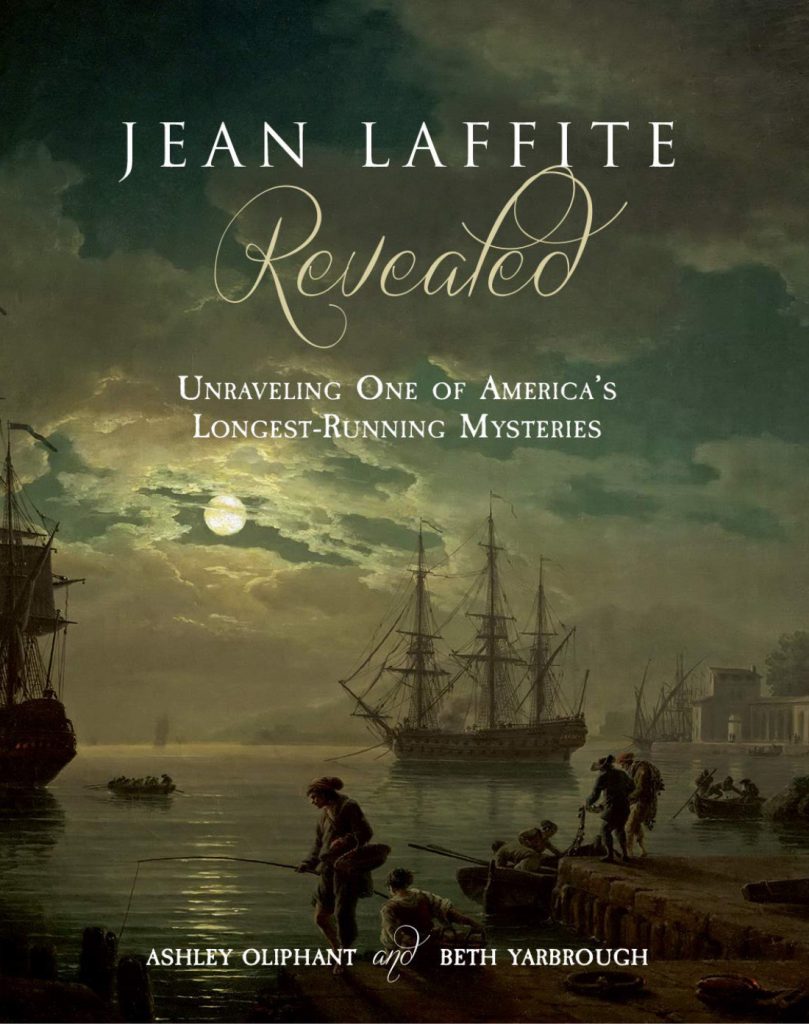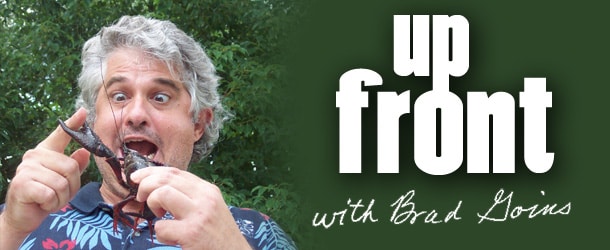Longtime Lake Area residents will know that there are lots of myths about Jean Lafitte circulating out there. A new book from the University of Louisiana-Lafayette Press — Jean Laffite Revealed — is intended to clear up at least a few of these myths.

The biggest myth, say Oliphant and Yarbrough, is that Laffite died somewhere in the Yucatan peninsula in the 1820s. They say that Laffite was alive and well and working under an assumed name in North Carolina at least until the end of the 1830s.
We’ll get back to that in a minute. But first let’s look briefly at some of the biographical material the new book lays out. The authors break down the entire Laffite biography, including his extensive involvement in the Battle of New Orleans in 1815, as the concluding battle of the War of 1812. They maintain that Laffite pretended to be on board with the British to buy himself time to notify his home city of New Orleans of the British military’s plans to attack. However, they assert, New Orleans wanted nothing to do with Laffite’s pirates and, in fact, burned their headquarters in the islands of Barataria to the ground.
Laffite used his connections to convince U.S. Gen. Andrew Jackson, who was defending New Orleans, to accept the pirates as allies. (It would be another eight years before Jackson became president.) Once Laffite was on board with Jackson and the American troops, he gave them 7,500 flints for their guns and the services of 1,000 pirates for manpower. Jackson promised to repay these favors by releasing any pirates who were taken prisoner and granting full pardons.
Did the pirates help? We know it took the Americans no more than half an hour to defeat the British and that the American side had only 60 casualties.
Whatever Laffite did in the Battle of New Orleans, it was enough to earn a public thank-you from Jackson, as well as an invitation to a parade and ball. But when the ball was over, Jean and his brother Pierre again found themselves without a base and low on funds.
Many will know that it wasn’t long (in 1817, in fact) until Jean set up a new base in Galveston in a large camp he called Campeche. Laffite made good profits from Sabine River trade for about a year. By then, it was time for a hurricane to strike. Campeche was wiped out, with only a few support beams left standing.
The story goes that by this point, the pirates decided they’d had enough and left Jean and Pierre to their own devices. The two headed to the Yucatan peninsula. And the generally accepted notion is that sometime in the next decade, Jean died in that location. (We do know that Pierre breathed his last in Mexico in 1821.)
This brings us to Jean Laffite Revealed, whose authors say they tracked Laffite to Copiah County in Mississippi in the 1830s, where he became a land speculator work-ing under the name Lorenzo Ferrer. It was in Mississippi, they say, that he met the Henderson family of Lincolnton, N.C., who convinced Laffite-Ferrer to relocate to their hometown.
The authors say that Laffite shows up in 1839 in Lincoln County using his fake name, which, on the taxpayers’ roll, is spelled “Loranzo” rather than Lorenzo. They add that Laffite spent time in the company of a beautiful woman named Louisa. He fit into town life well, even becoming the treasurer of the local Freemason lodge.
But there were still signs of his real identity, one of which was a sword that bore the initials J.L. that he, apparently, never bothered to hide. The ULL Press promises that the authors present a great deal of evidence for their theory, making use of everything from handwriting samples to tax records to an especially revealing passage in Laffite’s will. In marketing the book, the ULL Press says that its “true story” features “Freemason plots, double agents, jail breaks, faked deaths and murder.”
Sounds like pretty compelling stuff. The paperback book retails for $20 at ulpress. org. The information in this column came from a review by Erin Bass titled “A pirate gets his due” that appeared in the Lafayette magazine The Current.
Gators Back In Business
One of the area attractions that’s again up and running after COVID restrictions and hurricane damage is the Gator Chateau in Jennings. The chateau is returning to its regular schedule of public viewings of the gator feedings. If you want a look, show up any Friday at 3:30 pm. The viewings go on through September. The site for the chateau is inviting users to “Hold Our Baby Gators!” which is an indication to me that it’s also once again possible to hold an alligator at the chateau. While I like to do this myself, I assume it’s a feature that’s intended primarily as an attraction for children, who do seem to love it. The site lists Monday through Saturday 9 am through 5 pm as the hours. Learn more at jeffdavis.org/gator-chateau or call 337-821-5521.
The Southerly Take On SWLA
Since August, 2020, a new journalistic venue called Southerly has been running a series of stories documenting the efforts of those in Southwest Louisiana to cope with the effects of two hurricanes. The correspondent who’s writing the stories is Carly Berlin. She’s paying particular attention to the slow response by federal agencies, ef-fects on the mental health of locals and hindrances to reliable internet access in the area. Particular stories in the series cover such topics as ways in which local teachers are recovering (in a story titled “They’re So Weary”); local evictions after the hur-ricanes; and a Southwest Louisiana effort to shelter homeless people during the ice storm. These are just a few in the series. Several of Berlin’s stories were supported by grants from the Pulitzer Center’s Connected Coastlines Project. Southerly’s slogan is “Ecology + Justice + Culture in the American South.” It cov-ers developments in two broad areas: the Gulf Coast and Appalachia. You can learn more at southerlymag.org.
‘Spark Box’ Gets Families Reading
When the COVID-19 quarantine was in place, the Prime Time program of the Louisiana Endowment of the Humanities distributed first aid kits in boxes to 800 Louisiana families. The Prime Time program is building on that earlier project and has now developed the Spark Box, which is designed for situations in which “in-person programming is not available.” Unlike the earlier first aid box, which was geared toward immediate practical needs, the new Spark Box is all about families reading together.
Each Spark Box includes a set of books, a Grown Up Guide for parents or other caregivers and various supplies that are useful for learning literacy activities. Everything in the box is designed to “spark” family discussions about the humanities, add books to the family’s home library and create a lifelong love of reading in the home. Prime Time will distribute 300 Spark Boxes to families by the end of the summer. To learn more, go to the Louisiana Endowment for the Humanities website at leh.org.
Summer Meals Delivered
The City of Lake Charles will deliver meals free of charge to children 18 and younger through July 30. All children within Lake Charles city limits are eligible. Deliveries will include breakfast, lunch and snack items. To register, parents need to go to form.jotform.com/211315654011138 or cityo-flakecharles.com/summerfeeding to find the application form. They’ll need to fill out the entire form and then submit it electronically. For more information, call (337) 491-1270. The City of Lake Charles Summer Food Service Program is the result of a part-nership with The Healthy School Food Collaborative.
‘Louisiana Style’ Not The Same As ‘Louisiana’
In any bar or diner in Southwest Louisiana, I think you could easily work up a fervent debate about which Louisiana hot sauce is the best. I think everyone participat-ing in the debate would assume that every Louisiana hot sauce is made in Louisiana without even feeling any need to call attention to the matter. Imagine our surprise in the Lagniappe editorial offices when we got an email on June 7 from the Gaslamp Restaurant in San Diego proudly proclaiming that the venue makes “the #1 Louisiana Style Hot Sauce in the USA.” Say what? Some readers will already have guessed that the key to solving this mys-tery lies in the difference between the word “Louisiana” standing alone and the words “Louisiana Style.” Gaslamp doesn’t make Louisiana hot sauce; it makes “Louisiana style” hot sauce.
If you should happen to find yourself driving through San Diego, and you should happen to make it to 5th Avenue and Market Street, you can obtain a free bottle of “Red Beards Hot Sauce.” Of course, you’ll need to provide proof that you parked at either Park It or Parkade. That’s what the press release says. It also says you’ll need to pick up your hot sauce at “The New Normal is Now Pop-Up Hot Sauce Stand.” Guess that’s how they do things in San Diego. And remember: “Red Beards Hot Sauce has been voted the #1 Louisiana Style Hot Sauce in the USA!”
















Comments are closed.